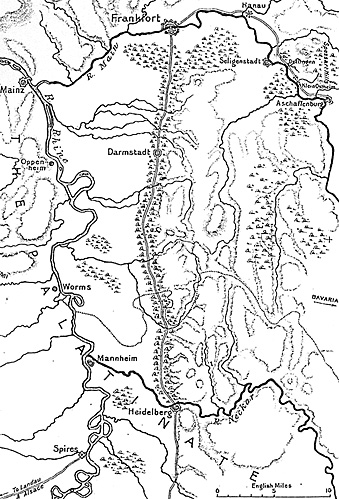 In late June of 1743, the "Pragmatic Army" of British, Austrian and Hanoverian troops found itself trapped in the narrow valley of the Main River, between the towns of Dettingen and Aschaffenburg see upper right section of map. The French Marshal Noailles had blocked the allied advance upstream at Aschaffenburg and now he intended to close the trap by sending his nephew, the Duc de Grammont, and 30,000 men ahead of the expected allied retreat. Grammont had the elite of the French army, the Maison du Roi (the King's Household Cavalry) and the Gardes Francaises at his disposal and he held a strong defensive position behind the Forchbach Stream at Dettingen.
In late June of 1743, the "Pragmatic Army" of British, Austrian and Hanoverian troops found itself trapped in the narrow valley of the Main River, between the towns of Dettingen and Aschaffenburg see upper right section of map. The French Marshal Noailles had blocked the allied advance upstream at Aschaffenburg and now he intended to close the trap by sending his nephew, the Duc de Grammont, and 30,000 men ahead of the expected allied retreat. Grammont had the elite of the French army, the Maison du Roi (the King's Household Cavalry) and the Gardes Francaises at his disposal and he held a strong defensive position behind the Forchbach Stream at Dettingen.
Noailles proposed to let the allies starve and "stew in their juices" for awhile; to surrender or attack a strong position, and then victory would belong to France. Instead, Grammont's impatience and deadly British musketry turned the ensuing Battle of Dettingen into another in a series of British victories over French arms. Dettingen also has the distinction of being the last occaision in which an English sovereign commanded his troops in the field.
Historical Background
How did King George II of England and the Pragmatic Army find itself in such a curious position in the first place? France and Britain were not technically at war, but in the dispute over Maria Theresa's succession to the Habsburg domain, Marshal Noailles and 50,000 French troops were acting as paid auxiliaries to the Bavarian Elector Charles Albert and his claim to the Imperial throne of the German Empire (the Holy Roman Empire). Britain had 16,000 men in Flanders acting as auxiliaries to Austria. In April 1743, these troops and other allied "auxiliaries" formed the Pragmatic Army and were ordered to advance to the Rhine River to intercept Noailles.
King George II of England was also the Elector of Hanover and feared that a confrontation with France would spill over into Hanover. So he ordered the British commander, Lord Stair, to only shadow the French and avoid battle. Stair was to camp along the Main River and await the arrival of King George and his Hanoverian and Hessian troops. Stair disobeyed his orders and crossed to the south bank of the Main, thereby attacting the attention of Noailles. When the Austrians refused to follow Lord Stair across the Main, the British retreated across the river and marched upstream instead. By the time the king and his son, the Duke of Cumberland, arrived the situation was critical.
Noailles realized that the allies' supply lines were stretched thin, and when Lord Stair advanced up the Main towards Aschaffenburg, the French marshal formulated his plan to trap the Pragmatic Army. The Main River valley between Dettingen and Aschaffenburg was very narrow. Stair's army was located on the right bank (north) of the river on a small plain. The steep and heavily-wooded Spessart Hills blocked any movement to the east, while the river itself precluded movement west, except at the stone bridge at Aschaffenburg. Noailles beat the allies to this key position and cut their supply lines into Franconia.
When the king arrived, he realized the danger immediately and ordered Stair to move back downstream towards Hanau, where plenty of food and 12,000 reinforcements awaited. Noailles anticipated this move and sent Grammont three miles ahead of the allied retreat, crossing the Main over two pontoon bridges at Seligenstadt. Then Grammont marched to Dettingen to await the inevitable allied retreat. Noailles intended to attack the Pragmatic Army from the front and rear: Grammont at Dettingen and Noailles with the rest of the French army following up from Aschaffenburg. And to spice things up a bit, the crafty Noailles constructed five batteries of 18 pound cannon at various points between the two villages, on the opposite bank of the Main.
Battle of Dettingen: June 27, 1743
- Historical Background
Battlefield Terrain and Deployment
The Battle of Dettingen
Wargaming Dettingen
Back to Seven Years War Asso. Journal Vol. VI No. 3 Table of Contents
Back to Seven Years War Asso. Journal List of Issues
Back to Master Magazine List
© Copyright 1993 by James E. Purky
This article appears in MagWeb (Magazine Web) on the Internet World Wide Web.
Other articles from military history and related magazines are available at http://www.magweb.com